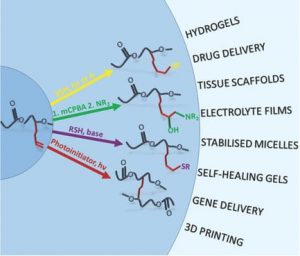When addressing biomedical applications, requirements for materials will comprise specific bulk properties, such as elasticity and thermal transitions; functions of the material, such as the rate of degradation; as well as the design of the biointerface enabling, for example, tissue integration. Inspiration for biomaterial research can also be found in the structures and properties of materials in nature, representing a kind of default. Therefore, biomaterial research has to be seen between the poles of envisioned application and biological principles. In the course of designing polymers for biomedical applications, researchers may encounter limitations, such as the insurmountable complexity of structures, when trying to analyze and emulate natural structures such as the extracellular matrix.
 In a special issue guest-edited by D. W. Grijpma and A. Lendlein, Macromolecular Bioscience covers several promising approaches to tailor and control the properties and functions of polymers for medical applications. The chemical structure of the macromolecules forming the bulk material as well as the chemistry of the material surface influences various properties and functions of biomaterials. Processing techniques are of similar importance as biomaterial morphologies and surface topology largely influences, for example, biofunctionality. This toolbox can be used to create implants with tailorable multifunctionality.
In a special issue guest-edited by D. W. Grijpma and A. Lendlein, Macromolecular Bioscience covers several promising approaches to tailor and control the properties and functions of polymers for medical applications. The chemical structure of the macromolecules forming the bulk material as well as the chemistry of the material surface influences various properties and functions of biomaterials. Processing techniques are of similar importance as biomaterial morphologies and surface topology largely influences, for example, biofunctionality. This toolbox can be used to create implants with tailorable multifunctionality.
Read selected papers of this issue for free for a limited time:
- Anthony W. Thomas, and Andrew P. Dove review different Postpolymerization Modifications of Alkene-Functional Polycarbonates for the Development of Advanced Biomaterials.
- Zeynep E. Yilmaz and Christine Jérôme highlight Polyphosphoesters: New Trends in Synthesis and Drug Delivery Applications

















